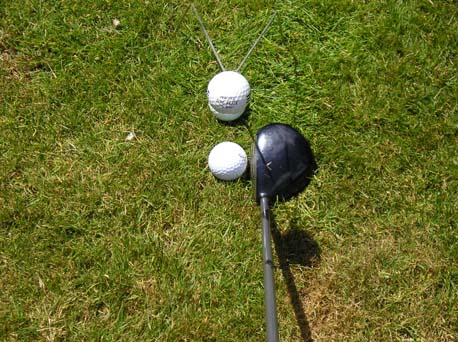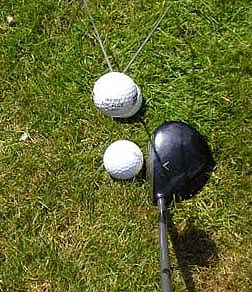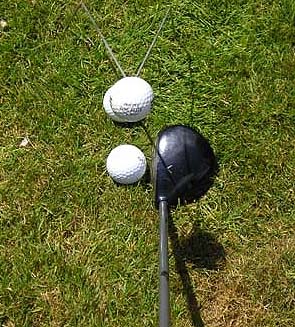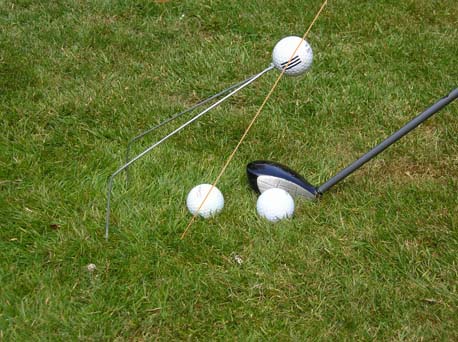Head
Position Throughout the Swing Process. (Changed - 16/03/2019)
The headrite is a device that I invented, it is simple to use and is supplied with the ball attached to the device and complete with simple instruction of how to use it.
The purpose of the device is to train the golfer to keep the head in the original address position until well after the ball has been struck.
This is achieved by ensuring that the ball that is attached to the device is always covering the ball that is placed on the ground, adjacent to the ball this is to be struck.
You can purchase this item for a cost of only £18 ( including P&P)
Delivery - To UK destinations 7 days, ( Outside the UK - 10/14 days)
If you wish to hit the ball in the direction you are aiming, the lateral position of the golfer's head at the impact position must be the same position that the golfer sets the head at the address position,
I have taken a few photo's to illustrate how your lateral head position at the impact position affects the alignment of the club head at the impact position.
(1)

This photo shows the address position where the perfect impact position is where the two golf balls at the top of the photo are laterally and horizontally aligned whilst the golf ball that you actually strike is adjacent to the club head.
(When in actual use the top ball would completely hide theball which is adjacent to the ball that is to be struck. (See figure 4)
However in order to show that there is two balls, I have deliberately miss aligned the ball in order to show part of the bottom ball.
Therefore in this photo as well as the golf balls being laterally and horizontally aligned, the club face is square to the target line, but importantly, the head is in the original address position at the point of impact.
(2)

This is a different photo which show the view that the golfer would see if they fail to return the head to the original address position at the precise moment the club head strikes the ball.
You will note that in this photo, because the golfer's head failed to return to the original address position at impact, the visual impression shows that the ball attached to the device is slight to the left of the ball placed on the ground (Notice the difference between this photo and the first photo) and this lack of getting the head back to the original address position at impact has a profound effect upon the alignment of the club face.
In this instance the club head will be slightly closed at impact, furthermore the bottom of the swing arc has also moved slightly back, which increases the possibility of the club head striking the ground before making contact with the ball thus causing the ball to hook to the left and also fly on a lower trajectory.
(3)

This is a different photo where the golfer's head has gone beyond the original address position at the point where the club head strikes the ball.
You will note that in this photo, because the golfer's head has gone beyond the original address position at impact, the visual impression shows that the ball atached to the device is slightly to the right of the ball that was placed on the ground. (Notice the difference between this photo and the first photo) and the action of allowing the golfer's head to go beyond the original address position at impact has a profound effect upon the alignment of the club face.
In this instance the club head will be slightly open at impact, furthermore the bottom of the swing arc has also moved slightly forward, which increases the possibility of the club head striking the ball thin before making contact with the ball thus causing the ball to slice to the right and also fly on a higher trajectory.
(4)

This is a side view.
The yellow line depicts the line of sight as the golfer addresses the ball.
No Head Movement.
Jack Nicklaus was taught the finer points about golf by
Jack Grout, a well known golf instructor of his day.
One of the many things Jack Nicklaus remembers about the
instruction, was that in order to teach him to keep his head
firmly positioned slightly behind the ball and in the frontal facing condition whilst he performed the golf swing, Jack
Grout would have an assistant grab the hair on Jack Nicklaus`s
head so tightly that if the head moved at all it would be very
painful.
Sam Torrance, a former Ryder Cup Player and Past Captain
for the European team, said that his father used to do exactly
the same to him when he was young.
Therefore in both cases it clarified the importance of totally
eliminating any lateral, vertical or rotational head movement
until the club head has reached the bottom of the swing arc.
I cannot state this fact too strongly. --
It is absolutely vital that once the position of your head has
been set at the address position you must concentrate in order
to eliminate any lateral movement away from the original address
position throughout the complete golf swing movement. ( See this VIDEO that I found on YouTube.)
However, although some golfers deliberately
allow the head to move laterally away from the original address position
during the back swing movement, as the down swing/follow
through movement is performed, as the head sways back to the original address position, the head must not move laterally
past the original address position.
You will not stop any lateral movements completely, but if you
can dramatically reduce any lateral movement of the head away
from the original address position as you perform the complete
golf swing, your golf shots will dramatically improve.
You must try to hold the head in this position throughout the
back swing, the down swing movement and into the follow through
movement - with extra care being taken to hold the head in this
position as the club head swings through the contact area.
I can speak from experience, having just
won an important knockout competition by sticking rigorously
to this principle that I promote, so make it a priority to master
this basic principle.
( If you fix your focus on the back edge of the golf ball from the moment you address
the ball and hold it throughout the complete golf swing you
will find this task easier to do.)
I can assure you that once you are aware
of how important it is to hold the head firmly in this position
at all times, the accuracy of your shots will dramatically improve.
Absolute Vital Actions.
The ability to keep the head held in the original address position
throughout the complete golf swing movement is not easy at first,
but with concentration this is achievable.( See Headrite)
Therefore if you wish to play consistently good golf it
is important that you force yourself to stop any lateral movement
of the head throughout the complete swing movement and ensure
this happens every time you swing the golf club.
When this is coupled with the action of watching the ball until
the precise moment the it is struck and also
maintaining the upper body angles until the end of the golf
swing, you will see a dramatic improvement in the quality of
your golf shots.
In order to understand what is meant by holding the head
firmly positioned so that the left eye is slightly behind the
ball, carry out the following exercise, which slightly exaggerates
the ball position :-
Take your normal address position with the head positioned
directly over the centre of your stance, but place the golf
ball on a tee peg adjacent to the big toe of the left foot.
As you look directly down to the ground at the centre of
your stance, you will note the golf ball appears to be well
to the left of your head position.
Make a very slow half back swing movement keeping the head
firmly positioned over the centre of your stance -and then whilst
performing the down swing movement, keep the head firmly positioned
over the centre of your stance and ensure that the head remains
in this position whilst the club head swings past this position
in order to strike the ball.
That is how it feels when you perform the full golf swing
movement. However, during the full golf swing
the ball position will be nearer the centre of the stance than
the example as described above, but the feeling you must have
is of the passive arms/club head swinging past the position
directly below your head -- before the club head strikes the
ball.
The left eye must be slightly behind the ball at the precise
moment the club head makes contact with the ball.
You must concentrate on the task.
If I can do it -- so can you.
Therefore the critical point in the golf swing is at the
precise moment the club head makes contact with the ball.
At that point you must ensure that the head is firmly held in
place so that the left eye remains slightly behind the ball
position -- and if you wish to play very good golf it is absolutely
vital that the head is held in this manner with "pinpoint accuracy" until
well after the ball has been struck.
( Imagine your head being held firmly in place by two wooden
posts fixed into the ground and placed either side of your head
thus holding the head very still.)
Therefore regardless of the position of the ball at the address position,
either to the left of the centre of the stance for the driver,
or nearer to the centre of your stance for the short irons,
adjust your stance accordingly so that the head is always positioned
so that the left eye is slightly behind the ball at the address
position and subsequently at the impact position.
You have to concentrate very hard to keep the head positioned
so that the left eye is slightly behind the ball at the precise
moment the club head makes contact with the ball, but the effort
is very worthwhile.
Therefore during the down
swing movement you have to be obsessive to ensure that your
head remains firmly held in the original address position at
all times but especially whilst the club head swings through
the contact area and on to the bottom
of the swing arc.
We are only talking about the golfer allowing the head to
be only a fraction of an inch either side of the original address
position at the precise moment the club head makes contact with
the ball, but this is enough to cause the ball to be sliced
to the right of the target or hooked to the left of the target.
Another reason for maintaining the
head in this position with "pin point accuracy" is
that any lateral movement of the head at the point of impact,
no matter how minute, will cause the whole body to be out of
alignment, thus causing the position of the bottom
of the swing arc to vary.
For instance, if your head is beyond the original address position
at the precise moment the club head makes contact with the ball,
the bottom of the swing arc will automatically move forward
in the stance, resulting in the ball being struck with the leading
edge of the club, thus possibly causing a "thin" shot.
However if your head is behind the original address position
at the precise moment the club head makes contact with the ball,
the bottom of the swing arc will automatically move backwards
in the stance, resulting in the club making contact with the
turf before hitting the ball, thus possibly causing a "fat"
shot.
I cannot emphasis how
important it is to hold the head steady throughout the golf
swing.

